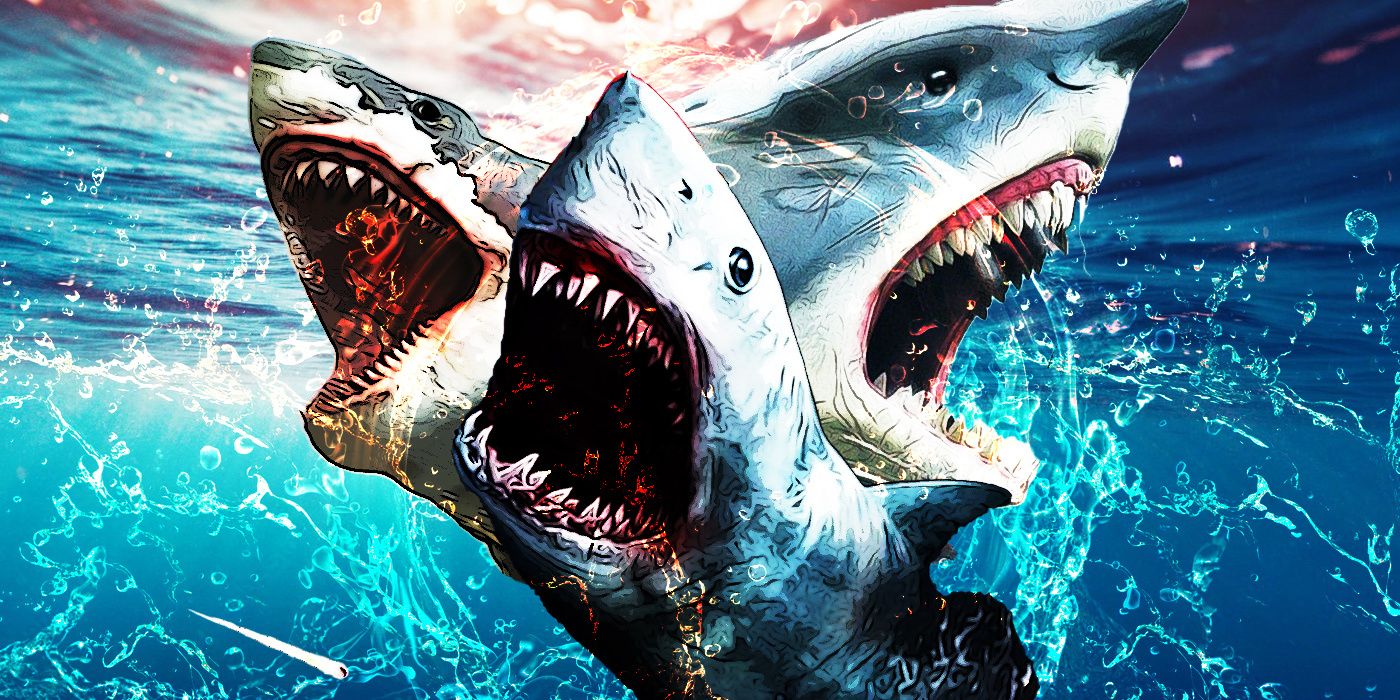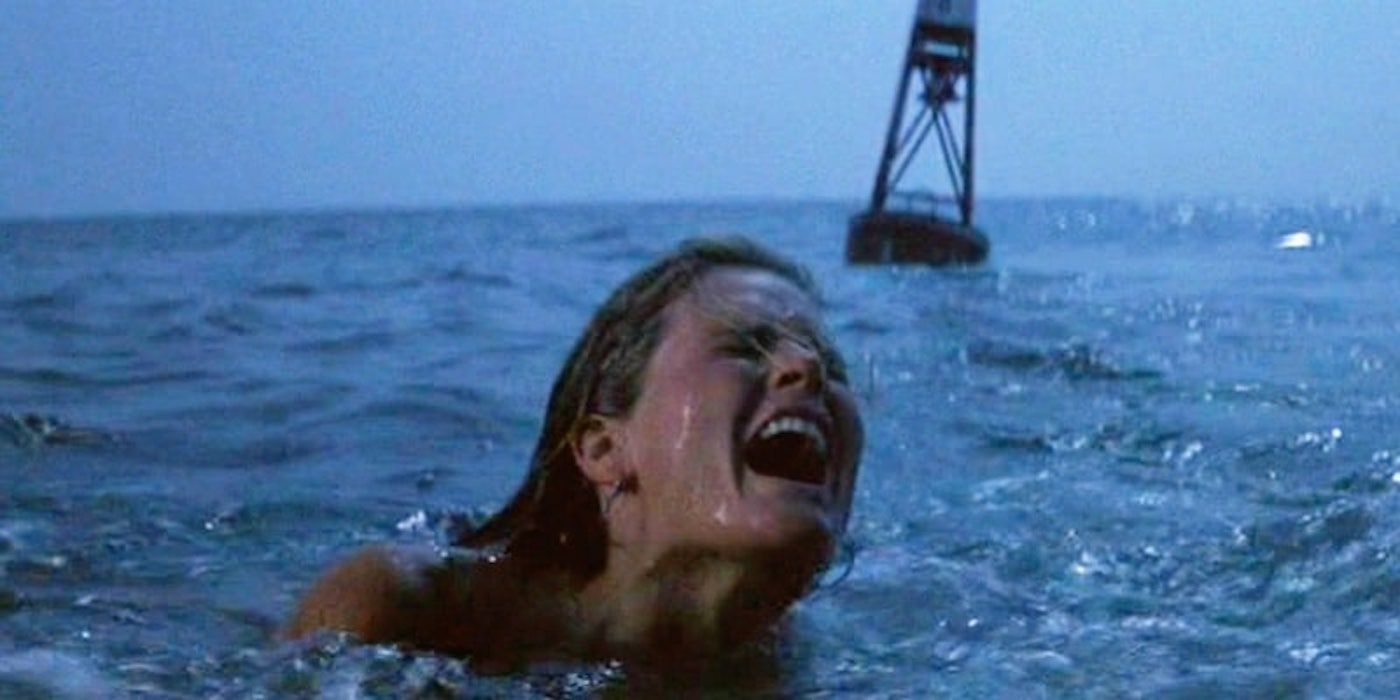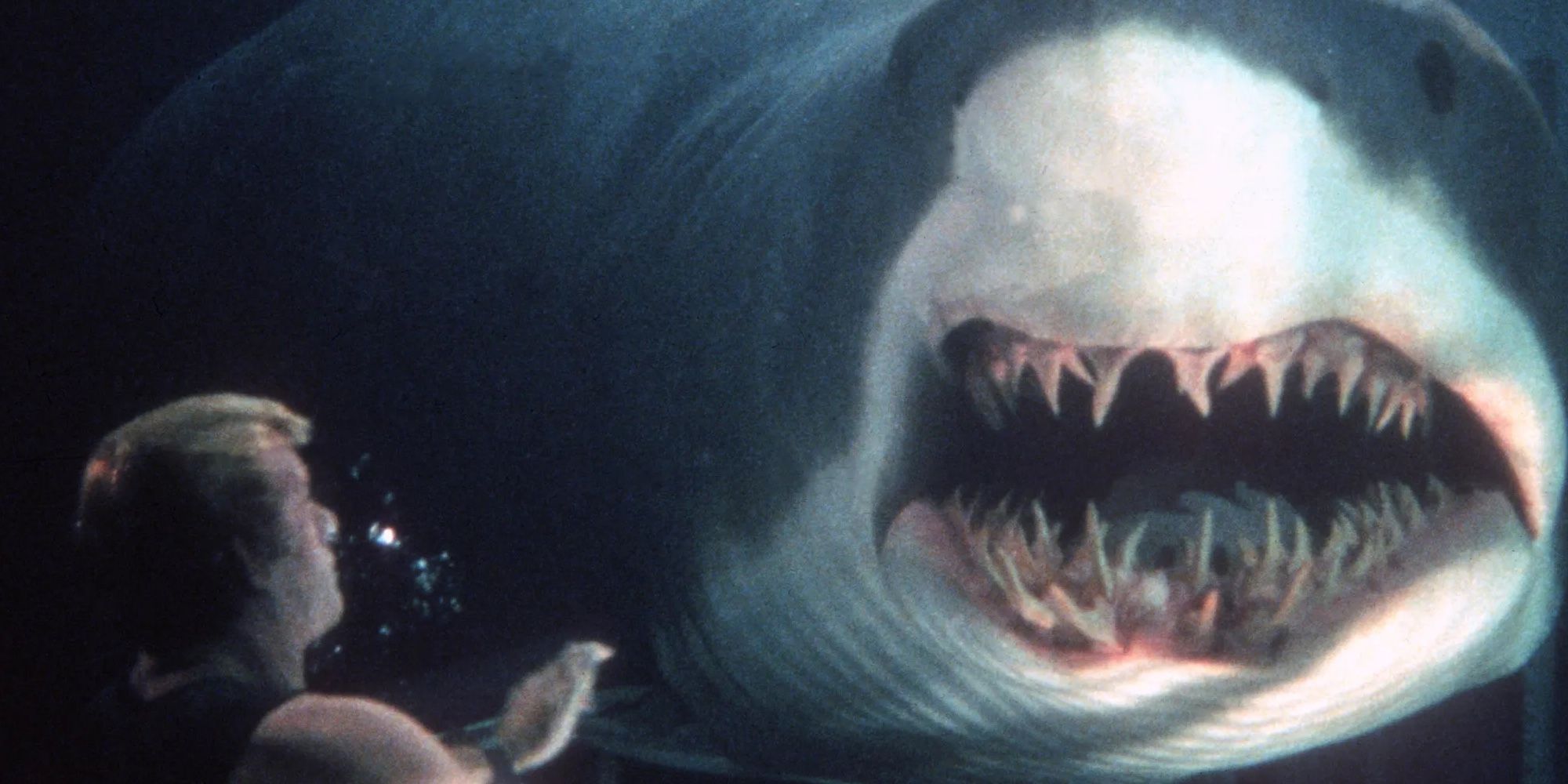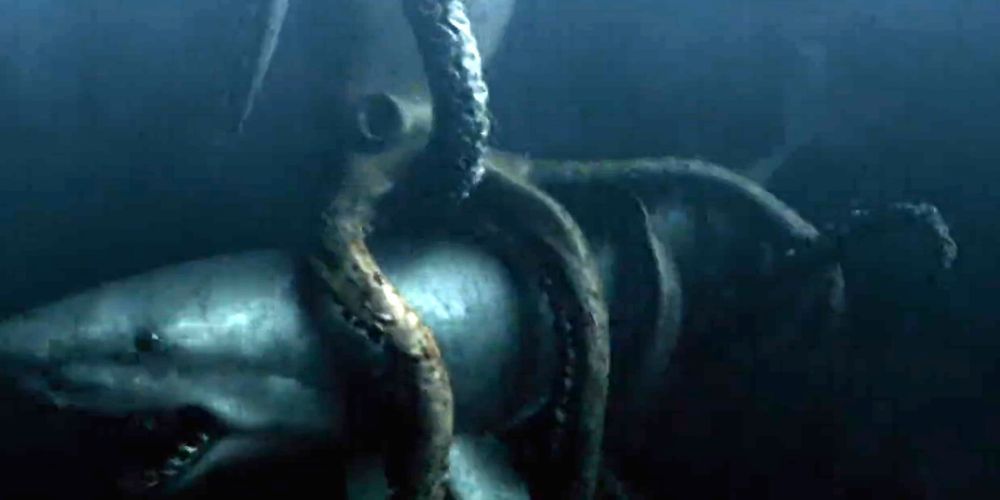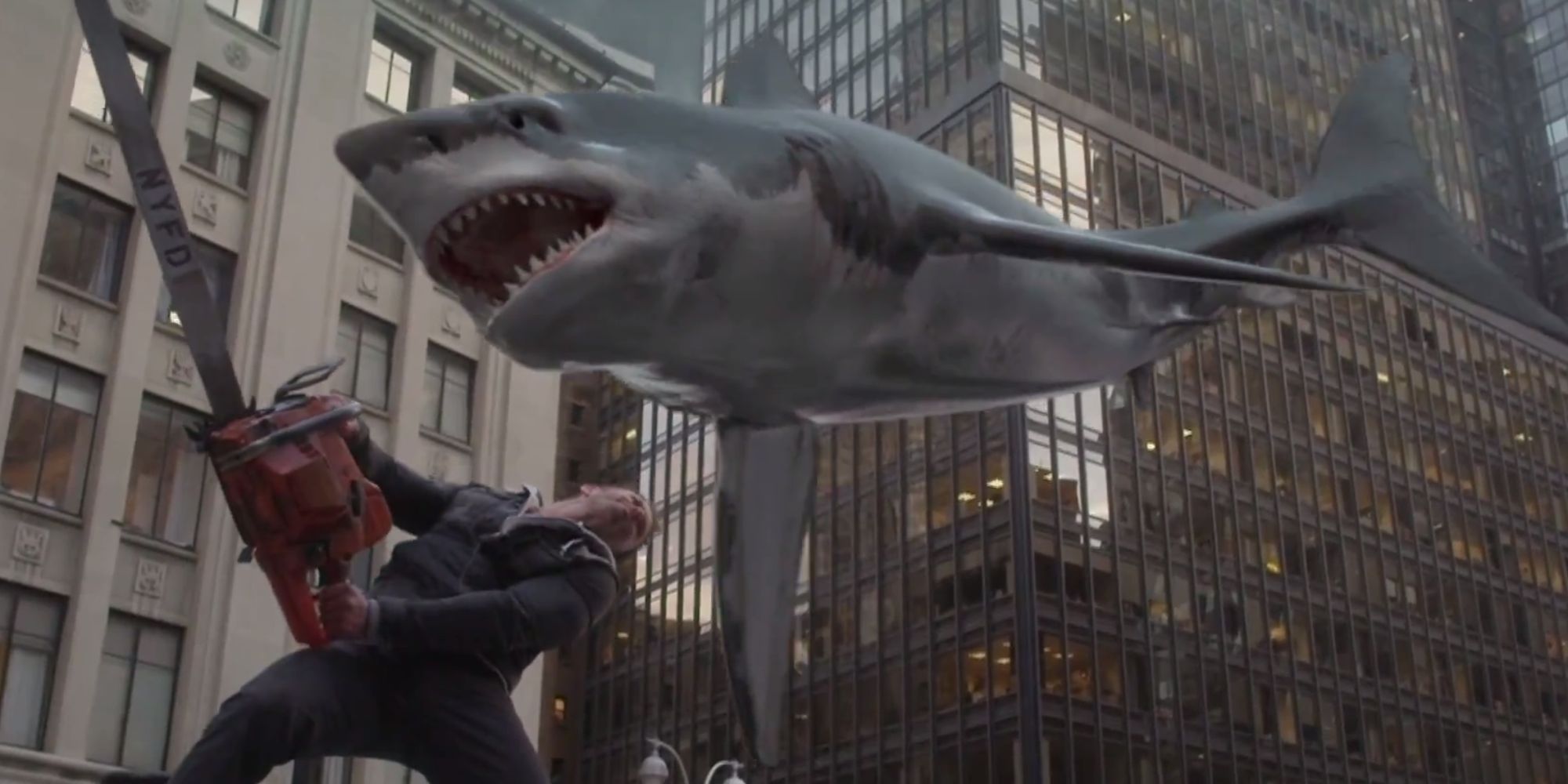We are absolutely fascinated by sharks. Discovery's 35th Shark Week kicked off on July 23rd, hosted by none other than Aquaman Jason Momoa himself. Not just sharks in real life, either. No, we love them on screen, and we like them schlocky. Sharknado, Deep Blue Sea, Sand Sharks, 6-Headed Shark Attack (or 2, 3, or 5), Sharktopus. And we are mere days away from the latest schlock-shark extravaganza, Meg 2: The Trench, which appears to have embraced its campiness wholeheartedly, as evidenced by the darkly humorous trailer for the film. Plus, Shudder make a whole documentary about this very topic called Sharksploitation which you can watch on the horror streamer now.
'Jaws' Started Our Love Affair With Shark Movies
Even Discovery isn't above dipping their toes in, with Cocaine Sharks being one of the many shark titles created to draw people in. Truly, no other creature even comes close to the quantity and — ahem — “quality” of sharks in B-Movies But why? It starts with 1975's Jaws, regarded as the first summer blockbuster and rightfully so. Steven Spielberg crafted an epic horror film, demonizing sharks as unseen predators that can show up and eat you before you know what’s happening. Despite being an unfair representation of sharks, the public’s perception of them was molded largely by the film, something Universal would use in the advertising for Jaws 2: “Just when you thought it was safe to get back in the water.”
Sharks were then viewed as feared predators on a global scale. They were unstoppable, soulless creatures; "It's got lifeless eyes, black eyes, like a doll's eyes. When it comes at you it doesn't seem to be livin'" Jaws' Quint (Robert Shaw) laments. With land predators, you can, conceivably, protect yourself from them since you can usually see them coming. But, you can't see a shark in the water (maybe a fin if you’re lucky); you are at your most vulnerable, a snack in a bikini. Three sequels later and Jaws became toothless. The fascination with sharks lacked the irrational fear of them.
‘Deep Blue Sea’ and ‘Open Water’ Brought Sharks Into the 21st Century
Two movies worked together to reawaken those fears: 1999's Deep Blue Sea and 2003's Open Water. Deep Blue Sea was the first major studio release featuring sharks since 1987's Jaws: The Revenge and while it couldn't do any worse, director Renny Harlin instead upped the ante. This wasn't a single shark wreaking havoc on a summer town. Deep Blue Sea had multiple sharks. Larger, faster, and smarter ones; always one step ahead and that made them deadlier. Combined with the spreading word about the surprising death of star Samuel L. Jackson halfway through the film, Deep Blue Sea was a success. More importantly, it made sharks a thing again. And if Deep Blue Sea reintroduced the shark to the movie-going public, then Open Water reopened the fear of them. Deep Blue Sea was fiction, but Open Water had its roots in the true story of Tom and Eileen Lonergan, left stranded in shark-filled waters. The movie not only preyed on the fear of sharks and being left stranded and helpless, but it dialed it up because this was based on a real story.
Sharks were now back in the spotlight, and the timing could not be any better. Affordable CGI effects opened the door for anyone to make a shark film and the advent of social media provided the means of promotion worldwide. In order to stand out, though, the stakes had to be raised. Sure, sharks were still frightening, but what’s more frightening than a shark? Shark hybrids. Sharks not restricted to the ocean. Sharks that are escapees of top secret government projects. Films were seemingly being released daily and people couldn't get enough. Not only was the object of their fears front and center, but now they existed in water, on ski hills, the beach, the sky, outer space, and even inland and they were drawn in by their fascination with what bizarre premise could possibly be next.
When Did Shark Movies Become So Schlocky?
This new age of schlock shark film began with 2005’s Hammerhead, also known as Sharkman, an original movie aired on the SyFy channel. (Fun fact: SyFy and independent film company, The Asylum, are responsible for the majority of B-grade shark movies from 2005 on.) It wasn't anything spectacular - scientist tries to find cure for son, inadvertently becomes half-man, half-shark, bitey bitey - and it didn't quite capture the public's attention; but, it was only the beginning. What did capture the public's attention was 2009's Mega Shark vs Giant Octopus, starring 1980s wunderkinder, Debbie Gibson and Lorenzo Lamas. The movie's trailer became a viral hit, scoring millions of views and the film delivered.
Two prehistoric titans are accidentally released into the open sea where they fight, cause chaos, and the Mega Shark even takes out a commercial airliner. The success of the film opened the floodgates for other shark schlock. Snow Shark: Ancient Snow Beast (2011) features a prehistoric shark that swims in the snow, terrorizing the residents of a small town. And if you thought you were safe in warmer climates, 2011's Sand Sharks features a group of monstrous beasts that swim through sand. 2-Headed Shark Attack in 2012 delivered on its promise of a shark with two heads.
'Sharknado' Marked the Start of the Massive Schlock Shark Movies Era
Then came 2013 and the first film in what would become a juggernaut franchise: Sharknado. It was an absolutely ridiculous premise, played seriously by the cast: a waterspout forms out in the ocean where it picks up sharks. The cyclone then heads towards Los Angeles where it drops sharks throughout the city, allowing them to feast on the population. Bar owner and ex-surfer Fin (Ian Ziering), his ex-wife April (Tara Reid), Fin's barmaid Nova (Cassie Scerbo), and Fin and April's son Matt (Chuck Hittinger) band together to stop the cyclone, now dubbed "sharknado" (talk about a biting wind, amirite?).
The task is complicated when one sharknado becomes three, but Fin figures out that they can put a stop to the teeth disaster by throwing a bomb in the center of the sharknado. He stops all three and saves his family by chainsawing a large shark in half. Sharknado would continue to raise the insanity through the course of 5 sequels, each upping the absurdity of the previous and building up to a finale that, somehow, uses time travel and androids. The franchise proved that there were absolutely no rules when it came to shark movies. Nothing was sacred, nothing was off-limits and it didn't matter.
Like any horror film, one reason why people keep watching schlock shark movies is because there is sensation attached to them. Any shark film, no matter how cheesy, is good for at least one jump scare. Another reason is the novelty. Seeing a shark in the water onscreen might be the same, but seeing a shark in space, or merged with an octopus, is a new experience, and in the highly unlikely event a sharknado hits your city, you are now prepared. The real draw, though, is the sharks themselves. Regardless of how preposterous the premise of a film may be, everyone sticks to the notion ingrained in society since Jaws: The shark is an unstoppable, soulless, force of nature, so single-minded in purpose that it almost shouldn't exist. That element still scares and captivates people in a way that no other creature comes close to emulating and so long as people continue to believe it, there is no escape.

